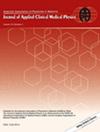Improving dose delivery in non-coplanar cranial SRS: Stereoscopic x-ray-guided mitigation of table walkout errors
Abstract
Purpose
Linear accelerator (LINAC)-based single-isocenter multi-target (SIMT) treatment has streamlined the cranial stereotactic radiosurgery (SRS) workflow. Though efficient, SIMT delivery adds additional challenges that should be considered, including increased sensitivity to rotational errors for off-isocenter targets. Room-mounted imaging systems carry the advantage of allowing fast, low-dose imaging at nonzero couch angles, which may combat the effects of table walkout and residual rotational errors. Here, we performed a series of end-to-end tests to determine if these corrections correlate with a measurable difference in delivered dose and to assess the overall accuracy of SIMT delivery on our LINAC-based SRS platform.
Methods
Ten treatment plans of increasing complexity were created in the Elements 4.0 treatment planning system (TPS, Brainlab AG). Plans were delivered on an Elekta Versa HD LINAC (Elekta AB) with the ExacTrac (ETX) imaging system (Brainlab AG). A CT scan of a StereoPHAN with SRS MapCHECK (Sun Nuclear) was imported into the TPS. Measured targets were contoured on the detector plane. Plans used 4–15 treatment arcs and 4–6 couch angles. ETX was used for initial phantom positioning. Dose measurements were performed for each plan with and without ETX-guided corrections at all table angles.
Results
Translational and rotational residual shifts were all submillimeter and ≤1.0 degrees, respectively, across all table angles. Using 3.0%/1.0 mm gamma criteria, all gamma pass rates (GPR) were either equal or improved when ETX shifts were executed, though the difference was not statistically significant (p = 0.076). However, using 2.0%/0.5 mm criteria, GPR improved significantly (p = 0.016) with ETX repositioning. The average GPR improvement was 4.5% ± 4.8%.
Conclusions
Results demonstrate that repositioning corrections at each table angle improve agreement between planned and delivered dose at the submillimeter level. The test treatment plans in this study may be used for assessment of end-to-end treatment delivery accuracy for complex LINAC-based stereotactic radiotherapy procedures.


 求助内容:
求助内容: 应助结果提醒方式:
应助结果提醒方式:


